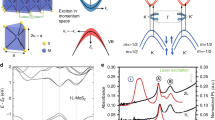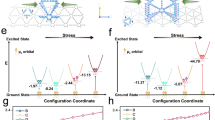Abstract
The introduction of lattice anisotropy causes Dirac cones to shift in response to the applied strain, leaving a pseudogap at the original Dirac points. Here, a group-theory analysis is combined with first-principles calculations to reveal the movement characteristics of Dirac points and band gaps in various graphynes under rotating uniaxial and shear strains. Graphene, where linear effects dominate, is different from α-, β-, and γ-graphynes, which generate strong nonlinear responses due to their bendable acetylenic linkages. However, the linear components of the electronic response, which are essential in determining material performance such as intrinsic carrier mobility due to electron–phonon coupling, can be readily separated, and are well described by a unified theory. The movement of the Dirac points in α-graphyne is circular under a rotating strain, and the pseudogap opening is isotropic with a magnitude of only 2% that in graphene. In comparison, the movement in β-graphyne is elliptical and the center is displaced from the origin. For γ-graphyne, three branches of gaps change with the applied strains with a sine/cosine dependence on the strain angle. The developed methodology is useful in determining the electronic response to various strains of Dirac materials and two-dimensional semiconductors.

Similar content being viewed by others
References
Avouris, P.; Chen, Z. H.; Perebeinos, V. Carbon-based electronics. Nature Nanotechnol. 2007, 2, 605–615.
Enyashin, A. N.; Ivanovskii, A. L. Graphene allotropes. Phys. Status Solidi B 2011, 248, 1879–1883.
Wang, J. Y.; Deng, S. B.; Liu, Z. F.; Liu, Z. R. The rare two-dimensional materials with Dirac cones. Natl. Sci. Rev. 2015, 2, 22–39.
Novoselov, K. S.; Geim, A. K.; Morozov, S. V.; Jiang, D.; Zhang, Y.; Dubonos, S. V.; Grigorieva, I. V.; Firsov, A. A. Electric field effect in atomically thin carbon films. Science 2004, 306, 666–669.
Castro Neto, A. H.; Guinea, F.; Peres, N. M. R.; Novoselov, K. S.; Geim, A. K. The electronic properties of graphene. Rev. Mod. Phys. 2009, 81, 109–162.
Malko, D.; Neiss, C.; Viñes, F.; Görling, A. Competition for graphene: Graphynes with direction-dependent Dirac cones. Phys. Rev. Lett. 2012, 108, 086804.
Baughman, R. H.; Eckhardt, H.; Kertesz, M. Structure property predictions for new planar forms of carbon: Layered phases containing sp 2 and sp atoms. J. Chem. Phys. 1987, 87, 6687–6699.
Haley, M. M.; Brand, S. C.; Pak, J. J. Carbon networks based on dehydrobenzoannulenes: Synthesis of graphdiyne substructures. Angew. Chem., Int. Ed. 1997, 36, 836–838.
Marsden, J. A.; Haley, M. M. Carbon networks based on dehydrobenzoannulenes. 5. Extension of two-dimensional conjugation in graphdiyne nanoarchitectures. J. Org. Chem. 2005, 70, 10213–10226.
Yin, W.-J.; Xie, Y.-E.; Liu, L.-M.; Wang, R.-Z.; Wei, X.-L.; Lau, L.; Zhong, J.-X.; Chen, Y.-P. R-graphyne: A new twodimensional carbon allotrope with versatile Dirac-like point in nanoribbons. J. Mater. Chem. A 2013, 1, 5341–5346.
Wang, X. Q.; Li, H. D.; Wang, J. T. Prediction of a new two-dimensional metallic carbon allotrope. Phys. Chem. Chem. Phys. 2013, 15, 2024–2030.
Haley, M. M. Synthesis and properties of annulenic subunits of graphyne and graphdiyne nanoarchitectures. Pure Appl. Chem. 2008, 80, 519–532.
Li, Y. J.; Xu, L.; Liu, H. B.; Li, Y. L. Graphdiyne and graphyne: From theoretical predictions to practical construction. Chem. Soc. Rev. 2014, 43, 2572–2586.
Peng, Q.; Dearden, A. K.; Crean, J.; Han, L.; Liu, S.; Wen, X.; De, S. New materials graphyne, graphdiyne, graphone, and graphane: Review of properties, synthesis, and application in nanotechnology. Nanotechnol. Sci. Appl. 2014, 7, 1–29.
Tahara, K.; Yamamoto, Y.; Gross, D. E.; Kozuma, H.; Arikuma, Y.; Ohta, K.; Koizumi, Y.; Gao, Y.; Shimizu, Y.; Seki, S. et al. Syntheses and properties of graphyne fragments: Trigonally expanded dehydrobenzo[12]annulenes. Chem.—Eur. J. 2013, 19, 11251–11260.
Desroches, M.; Courtemanche, M.-A.; Rioux, G.; Morin, J.-F. Synthesis and properties of rhomboidal macrocyclic subunits of graphdiyne-like nanoribbons. J. Org. Chem. 2015, 80, 10634–10642.
Cirera, B.; Zhang, Y.-Q.; Björk, J.; Klyatskaya, S.; Chen, Z.; Ruben, M.; Barth, J. V.; Klappenberger, F. Synthesis of extended graphdiyne wires by vicinal surface templating. Nano Lett. 2014, 14, 1891–1897.
Li, G. X.; Li, Y. L.; Liu, H. B.; Guo, Y. B.; Li, Y. J.; Zhu, D. B. Architecture of graphdiyne nanoscale films. Chem. Commun. 2010, 46, 3256–3258.
Li, G. X.; Li, Y. L.; Qian, X. M.; Liu, H. B.; Lin, H. W.; Chen, N.; Li, Y. J. Construction of tubular molecule aggregations of graphdiyne for highly efficient field emission. J. Phys. Chem. C 2011, 115, 2611–2615.
Zhou, J. Y.; Gao, X.; Liu, R.; Xie, Z. Q.; Yang, J.; Zhang, S. Q.; Zhang, G. M.; Liu, H. B.; Li, Y. L.; Zhang, J. et al. Synthesis of graphdiyne nanowalls using acetylenic coupling Reaction. J. Am. Chem. Soc. 2015, 137, 7596–7599.
Gao, X.; Zhou, J. Y.; Du, R.; Xie, Z. Q.; Deng, S. B.; Liu, R.; Liu, Z. F.; Zhang, J. Robust superhydrophobic foam: A graphdiyne-based hierarchical architecture for oil/water separation. Adv. Mater. 2016, 28, 168–173.
Zheng, J. J.; Zhao, X.; Zhao, Y.; Gao, X. Two-dimensional carbon compounds derived from graphyne with chemical properties superior to those of graphene. Sci. Rep. 2013, 3, 1271.
Huang, H. Q.; Duan, W. H.; Liu, Z. R. The existence/absence of Dirac cones in graphynes. New J. Phys. 2013, 15, 023004.
Li, Z. Z.; Wang, J. Y.; Liu, Z. R. Intrinsic carrier mobility of Dirac cones: The limitations of deformation potential theory. J. Chem. Phys. 2014, 141, 144107.
Chen, J. M.; Xi, J. Y.; Wang, D.; Shuai, Z. G. Carrier mobility in graphyne should be even larger than that in graphene: A theoretical prediction. J. Phys. Chem. Lett. 2013, 4, 1443–1448.
Ouyang, T.; Hu, M. Thermal transport and thermoelectric properties of beta-graphyne nanostructures. Nanotechnology 2014, 25, 245401.
Bardeen, J.; Shockley, W. Deformation potentials and mobilities in non-polar crystals. Phys. Rev. 1950, 80, 72–80.
Li, Y.; Jiang, X. W.; Liu, Z. F.; Liu, Z. R. Strain effects in graphene and graphene nanoribbons: The underlying mechanism. Nano Res. 2010, 3, 545–556.
Yang, L.; Han, J. Electronic structure of deformed carbon nanotubes. Phys. Rev. Lett. 2000, 85, 154–157.
Mohr, M.; Papagelis, K.; Maultzsch, J.; Thomsen, C. Twodimensional electronic and vibrational band structure of uniaxially strained graphene from ab initio calculations. Phys. Rev. B 2009, 80, 205410.
Vozmediano, M. A. H.; Katsnelson, M. I.; Guinea, F. Gauge fields in graphene. Phys. Rep. 2010, 496, 109–148.
Pereira, V. M.; Castro Neto, A. H. Strain engineering of graphene’s electronic structure. Phys. Rev. Lett. 2009, 103, 046801.
Pereira, V. M.; Castro Neto, A. H.; Peres, N. M. R. Tightbinding approach to uniaxial strain in graphene. Phys. Rev. B 2009, 80, 045401.
Farjam, M.; Rafii-Tabar, H. Uniaxial strain on gapped graphene. Phys. E 2010, 42, 2109–2114.
Wang, J. Y.; Zhao, R. Q.; Yang, M. M.; Liu, Z. F.; Liu, Z. R. Inverse relationship between carrier mobility and bandgap in graphene. J. Chem. Phys. 2013, 138, 084701.
Montambaux, G.; Piéchon, F.; Fuchs, J. N.; Goerbig, M. O. Merging of Dirac points in a two-dimensional crystal. Phys. Rev. B 2009, 80, 153412.
Dvorak, M.; Wu, Z. G. Dirac point movement and topological phase transition in patterned graphene. Nanoscale 2015, 7, 3645–3650.
Zhu, S.-L.; Wang, B. G.; Duan, L. M. Simulation and detection of Dirac fermions with cold atoms in an optical lattice. Phys. Rev. Lett. 2007, 98, 260402.
Wunsch, B.; Guinea, F.; Sols, F. Dirac-point engineering and topological phase transitions in honeycomb optical lattices. New J. Phy. 2008, 10, 103027.
Tarruell, L.; Greif, D.; Uehlinger, T.; Jotzu, G.; Esslinger, T. Creating, moving and merging Dirac points with a Fermi gas in a tunable honeycomb lattice. Nature 2012, 483, 302–305.
Hasegawa, Y.; Kishigi, K. Merging Dirac points and topological phase transitions in the tight-binding model on the generalized honeycomb lattice. Phys. Rev. B 2012, 86, 165430.
Wang, L.; Fu, L. B. Interaction-induced merging of Dirac points in non-Abelian optical lattices. Phys. Rev. A 2013, 87, 053612.
Ibañez-Azpiroz, J.; Eiguren, A.; Bergara, A.; Pettini, G.; Modugno, M. Self-consistent tight-binding description of Dirac points moving and merging in two-dimensional optical lattices. Phys. Rev. A 2013, 88, 033631.
Wu, C. J.; Bergman, D.; Balents, L.; Das Sarma, S. Flat bands and wigner crystallization in the honeycomb optical lattice. Phys. Rev. Lett. 2007, 99, 070401.
Yue, Q.; Chang, S. L.; Kang, J.; Qin, S. Q.; Li, J. B. Mechanical and electronic properties of graphyne and its family under elastic strain: Theoretical predictions. J. Phys. Chem. C 2013, 117, 14804–14811.
Zhang, S. Q.; Wang, J. Y.; Li, Z. Z.; Zhao, R. Q.; Tong, L. M.; Liu, Z. F.; Zhang, J.; Liu, Z. R. Raman spectra and corresponding strain effects in graphyne and graphdiyne. J. Phys. Chem. C 2016, 120, 10605–10613.
Lin, Z. R.; Liu, Z. R. Spin-1 Dirac-Weyl fermions protected by bipartite symmetry. J. Chem. Phys. 2015, 143, 214109.
Kresse, G.; Furthmuller, J. Efficiency of ab-initio total energy calculations for metals and semiconductors using a plane-wave basis set. Comp. Mater. Sci. 1996, 6, 15–50.
Kresse, G.; Furthmuller, J. Efficient iterative schemes for ab inito total-energy calculations using a plane-wave basis set. Phys. Rev. B 1996, 54, 11169–11186.
Kresse, G.; Hafner, J. Ab initio molecular dynamics for liquid metals. Phys. Rev. B 1993, 47, 558–561.
Kresse, G.; Hafner, J. Ab initio molecular-dynamics simulation of the liquid-metal–amorphous-semiconductor transition in germanium. Phys. Rev. B 1994, 49, 14251–14269.
Perdew, J. P.; Burke, K.; Ernzerhof, M. Generalized gradient approximation made simple. Phys. Rev. Lett. 1996, 77, 3865–3868.
Kresse, G.; Joubert, D. From ultrasoft pseudopotentials to the projector augmented-wave method. Phys. Rev. B 1999, 59, 1758–1775.
Cranford, S. W.; Buehler, M. J. Mechanical properties of graphyne. Carbon 2011, 49, 4111–4121.
Peng, Q.; Ji, W.; De, S. Mechanical properties of graphyne monolayers: A first-principles study. Phys. Chem. Chem. Phys. 2012, 14, 13385–13391.
Yang, Y. L.; Xu, X. M. Mechanical properties of graphyne and its family–A molecular dynamics investigation. Comput. Mater. Sci. 2012, 61, 83–88.
Zhang, Y. Y.; Pei, Q. X.; Wang, C. M. Mechanical properties of graphynes under tension: A molecular dynamics study. Appl. Phys. Lett. 2012, 101, 081909.
Couto, R.; Silvestre, N. Finite element modelling and mechanical characterization of graphyne. J. Nanomater. 2016, 2016, Article ID 7487049.
Cranford, S. W.; Brommer, D. B.; Buehler, M. J. Extended graphynes: Simple scaling laws for stiffness, strength and fracture. Nanoscale 2012, 4, 7797–7809.
Liu, M. J.; Artyukhov, V. I.; Lee, H.; Xu, F. B.; Yakobson, B. I. Carbyne from first principles: Chain of C atoms, a nanorod or a nanorope. ACS Nano 2013, 7, 10075–10082.
Gui, G.; Li, J.; Zhong, J. X. Band structure engineering of graphene by strain: First-principles calculations. Phys. Rev. B 2008, 78, 075435.
Kim, B. G.; Choi, H. J. Graphyne: Hexagonal network of carbon with versatile Dirac cones. Phys. Rev. B 2012, 86, 115435.
van Miert, G.; Juričić, V.; Smith, C. M. Tight-binding theory of spin-orbit coupling in graphynes. Phys. Rev. B 2014, 90, 195414.
Kang, J.; Li, J. B.; Wu, F. M.; Li, S.-S.; Xia, J.-B. Elastic, electronic, and optical properties of two-dimensional graphyne sheet. J. Phys. Chem. C 2011, 115, 20466–20470.
Lang, H. F.; Zhang, S. Q.; Liu, Z. R. Mobility anisotropy of two-dimensional semiconductors. Phys. Rev. B 2016, 94, 235306.
Acknowledgements
The authors thank Shuqing Zhang, Zeren Lin, and Ting Cheng for helpful discussions. The work was supported by the National Natural Science Foundation of China (No. 21373015).
Author information
Authors and Affiliations
Corresponding author
Electronic supplementary material
Rights and permissions
About this article
Cite this article
Li, Z., Liu, Z. & Liu, Z. Movement of Dirac points and band gaps in graphyne under rotating strain. Nano Res. 10, 2005–2020 (2017). https://doi.org/10.1007/s12274-016-1388-z
Received:
Revised:
Accepted:
Published:
Issue Date:
DOI: https://doi.org/10.1007/s12274-016-1388-z




